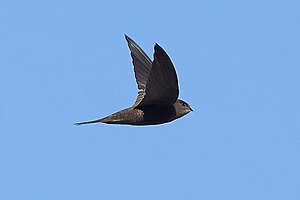Monochrome sailor
| Monochrome sailor | ||||||||||
|---|---|---|---|---|---|---|---|---|---|---|

Monochrome swift ( Apus unicolor ) on La Gomera |
||||||||||
| Systematics | ||||||||||
|
||||||||||
| Scientific name | ||||||||||
| Apus unicolor | ||||||||||
| ( Jardine , 1830) |
The monochrome swift ( Apus unicolor ) is a species of bird from the family of the sailors (Apodidae). It is a dark colored sailor of medium size. The species breeds in Madeira and the Canary Islands . The single-color swift is very similar to the closely related common swift in Central Europe . Like him, it is very sociable, with monochrome swifts often forming mixed swarms with wall swifts and pale swifts . The population is considered stable and the species is classified as safe.
description
With a body length of 14 to 15 centimeters and a wing length between 150 and 159 millimeters, the single-color sailor is slightly smaller than the common swift. As with this one, the crescent-shaped wings are long compared to the slender trunk and the tail is clearly forked. The color of the plumage is very dark black to gray-brown. The slightly lighter throat patch is very indistinct and out of focus. Both sexes look the same.
In the distribution area of the single-color swift, it is very difficult to distinguish it from the pale swift and the common swift . The latter meets the monochrome sailor during the train . An important differentiator is the shape. The single-color sailor looks even more streamlined and “sleek” than its two relatives. The wings and tail are longer relative to the trunk, the tail crotch is slightly deeper. Together with the wilder, dashing flight maneuvers, this is reminiscent of the representatives of the genus Cypsiurus .
The calls of the monochrome swift are very similar to those of the common swift ("srieh"), at most they are a little higher and a little more whistling. They can be heard all year round in the Canary Islands.
Spreading and migrations
The breeding area of the monochrome swift is limited to Madeira and the Canary Islands . It occurs all year round on these islands, only part of the population leaves the breeding area in winter and presumably overwinters exclusively in northwest Africa .
The single-color sailor is common in the Canaries, with the exception of Fuerteventura and Lanzarote , where there are rarer and only individual occurrences. In Madeira , the population is estimated to be 1000 to 2000 breeding pairs.
habitat
The single color sailor can be found in all habitats of the islands, including in the settlement area. It occurs from sea level up to an altitude of 2500 meters. The monochrome sailor is particularly common in deep gorges, especially in coastal areas. It also breeds on Madeira's highest peak, Pico Ruivo , where it nests in rock islands. In the winter quarters in Morocco , the monochrome sailor appears in the area of the cliff coast .
Reproduction
The breeding season runs from March to August. The monochrome swift is a colony breeder. The nests are found in caves and crevices on steep slopes on the cliff coast and in gorges, also inland. In addition, the species breeds under bridges and in crevices and cavities in buildings.
The bowl-shaped nest has a hollow one to two centimeters deep and 10 to 12 centimeters in diameter. Main components of the nest are fluffy seed container of composite flowers ; other vegetable matter and smaller man-made ingredients are also occasionally used. The nest is padded with feathers and all parts are glued with saliva.
The clutch consists of two eggs with an average size of 22 x 15 millimeters. Second broods are common.
Monochrome swifts show aggressive behavior in the vicinity of a breeding colony. Attacks on house martins ( Delichon urbicum ) have been reported several times, and it has also been observed how several single-color swifts drove away a much larger Alpine swallow ( Tachymarptis melba ).
Systematics
In the past , monochrome sailors and Alexander sailors were seen as con- specific. But today this is considered refuted. The Plain Swift belongs beside masonry Nyanza Swift for Apus - superspecies .
No subspecies are distinguished.
literature
- Phil Chantler, Gerald Driessens: A Guide to the Swifts and Tree Swifts of the World . Pica Press, Mountfield 2000, ISBN 1-873403-83-6 .
- Josep del Hoyo et al. (Ed.): Handbook of the Birds of the World. Volume 5: Barn-Owls to Hummingbirds. Lynx Edicions, 1999, ISBN 84-87334-25-3 .
Individual evidence
- ↑ This and all information not specially marked are taken from the following source: Chantler, Driessens: A Guide to the Swifts and Tree Swifts of the World . 2000, p. 224ff.
- ↑ BirdLife International: Species Factsheet - Plain Swift ( Apus unicolor )
- ↑ del Hoyo et al. (Ed.): Handbook of the birds of the world . 1999, p. 406f.
- ↑ Chantler, Driessens: A Guide to the Swifts and Tree Swifts of the World . 2000, pp. 25f.
Web links
- Apus unicolor in the endangered Red List species the IUCN 2008. Posted by: BirdLife International, 2008. Accessed October 13 of 2008.
- Image of a monochrome sailor in Madeira
- Feathers of the monochrome sailor